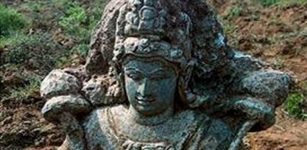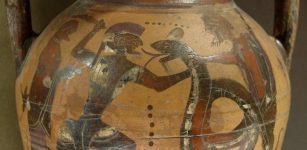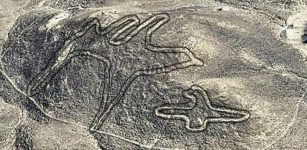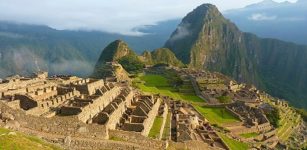Ancient High-Technology: Automatons In Greek Mythology
A. Sutherland - AncientPages.com - It cannot be denied that the concept of automation was known to the ancient Greeks. There is a good reason to believe that these ancient people had the skills to design self-operating machines but today we know about them only from mythical stories related to Hephaestus and a few others.
The world's first metallurgist and a master engineer, according to Greek mythology, was the blacksmith of the Olympian Gods, Hephaestus (or Vulcan, his Roman counterpart).
In Greek mythology, we come across detailed descriptions of devices created by Hephaestus and Talos was not the only creation of the master. Hephaestus produced golden walking statues which resembled young living women to serve him. They had their own voices, strength and helped him to walk.
The divine smith also created the Celedones (automotones or automata) - animate, golden statues that could sing. They became known as the magical singers standing at the Temple of the God Apollo at Delphi.
The automatons had the shape of either beautiful women, wryneck birds, or a combination of the two--sirens-like bird-women. Other interesting inventions of Hephaestus were the four bronze horse-shaped automotones that were used to draw the chariot of his two sons, the Kabeiroi.
Hephaistos made these machines by breathing defiant fire between their teeth, like the pair of brazen footed bulls which he made for Aietes the redoubtable ruler of the Kolkhians, with hot collars and burning pole. Eurymedon [one of the Kabeiroi] drove and guided the fiery mouths of the iron foot steeds with a fiery bridle" wrote Nonnus, a Greek poet in an epic tale of the god Dionysus.'
In Iliad, Homer writes about the Golden Tripods of Olympus: "[Hephaistos] was sweating as he turned here and there to his bellows busily, since he was working on twenty tripods which were to stand against the wall of his strong-founded dwelling. And he had set golden wheels underneath the base of each one so that of their own motion they could wheel into the immortal gathering, and return to his house: a wonder to look at. These were so far finished, but the elaborate ear handles were not yet on. He was forging these, and beating the chains out."
From Greek mythology, we also learn about a mechanical device known as the Kaukasian Eagle that was set by Zeus to feed on the ever-regenerating liver of the Titan Prometheus, after he was chained to the peak of Mount Kaukasos as punishment for stealing fire from the gods.
The eagle was described as a bronze automaton also constructed by Hephaestus.
The Olympian Gods used a set of twenty-wheeled tripods crafted by Hephaistos out of gold. They were automatic and wheeled themselves in and out of the halls of the gods as they were required.
In his epic poem Argonautica, Apollonius Rhodius says that when Hephaestus decided to give Aeetes, King of Kolkhis a present, he constructed a pair of fire-breathing bull-shaped automatons forged out bronze.
"He [Hephaistos] had also made him [Aeetes king of Kolkhis] Bulls with feet of bronze and bronze mouths from which the breath came out in flame, blazing and terrible. And he had forged a plow of indurated steel, all in one piece."
All as a thank-offering to Helios, who had taken him up in his chariot when he sank exhausted on the battlefield of Phlegra..."
Icarus' father, Daedalus was a skilled craftsman and he was also familiar with the ancient secrets of robotics. It is said he could create images that "moved about". Were these images in fact one of the first attempts to create an early form of television?
According to Plato, the Greek philosopher, Daedalus constructed human-like figures which moved on their own! Plato states that these robots were so active that they had to be prevented from running away.
From Garcilaso de la Vega (1501-1536), a Spanish soldier we learn that the Incas had a special statue in the Valley of Rimac "which spoke and gave answers to questions like the oracle of the Delphic Apollo."
Was Garcilaso de la Vega describing a computer?
The best way to prove the existence of ancient robots and computers is of course to present physical evidence rather than rely on myths, legends, and ancient scripts. We must not forget it is estimated that our planet has suffered at least five major catastrophes which caused the extinction of more than 50% of all species. Civilizations that existed prior to our own perished in violent cataclysms. If there are any surviving physical objects, then they are most likely buried deep in the oceans. How can we find them when most of our oceans are still unexplored?
Former civilizations possessed many scientific notions that we have today, including the concept of robotics and computer technology.
Written by – A. Sutherland - AncientPages.com Senior Staff Writer
Copyright © AncientPages.com All rights reserved. This material may not be published, broadcast, rewritten or redistributed in whole or part without the express written permission of AncientPages.com
Expand for referencesReferences:
More From Ancient Pages
-
 10th Century Sculpture Of Sun God Surya Accidentally Found In Farmland In Andhra Pradesh
Archaeology | Nov 16, 2020
10th Century Sculpture Of Sun God Surya Accidentally Found In Farmland In Andhra Pradesh
Archaeology | Nov 16, 2020 -
 Large, High-Elevation Cities Along Asia’s Silk Roads Exposed By High-Res Lidar
Archaeology | Oct 23, 2024
Large, High-Elevation Cities Along Asia’s Silk Roads Exposed By High-Res Lidar
Archaeology | Oct 23, 2024 -
 Early Christian Necropolis Unearthed In Sant’Appianu Cathedral In Sagone, Corsica
Archaeology | Aug 3, 2020
Early Christian Necropolis Unearthed In Sant’Appianu Cathedral In Sagone, Corsica
Archaeology | Aug 3, 2020 -
 Viking Fashion: Men And Women Were Vain And Very Clean During The Viking Age
Ancient History Facts | May 17, 2024
Viking Fashion: Men And Women Were Vain And Very Clean During The Viking Age
Ancient History Facts | May 17, 2024 -
 Dark And Light Sides Of Pax Romana: Great Political Slogan Introduced After Civil Wars
Ancient History Facts | May 20, 2023
Dark And Light Sides Of Pax Romana: Great Political Slogan Introduced After Civil Wars
Ancient History Facts | May 20, 2023 -
 Has A Herculaneum Scroll Solved The Mystery Of Plato’s Death?
Linguistic Discoveries | May 8, 2024
Has A Herculaneum Scroll Solved The Mystery Of Plato’s Death?
Linguistic Discoveries | May 8, 2024 -
 Great Living Chola Temples: Outstanding Workmanship Of Chola Dynasty Builders Of South India
Civilizations | May 31, 2024
Great Living Chola Temples: Outstanding Workmanship Of Chola Dynasty Builders Of South India
Civilizations | May 31, 2024 -
 On This Day In History: King John Of England Died – On Oct 19, 1216
News | Oct 19, 2017
On This Day In History: King John Of England Died – On Oct 19, 1216
News | Oct 19, 2017 -
 Cadmus – Legendary Phoenician Hero And Founder Of Prosperous City Of Thebes
Featured Stories | Sep 6, 2023
Cadmus – Legendary Phoenician Hero And Founder Of Prosperous City Of Thebes
Featured Stories | Sep 6, 2023 -
 Amazing Prehistoric Forest Submerged Under Water Thousands Of Years Ago Re-Emerges On Welsh Beach
Archaeology | Nov 11, 2022
Amazing Prehistoric Forest Submerged Under Water Thousands Of Years Ago Re-Emerges On Welsh Beach
Archaeology | Nov 11, 2022 -
 Anomalous Ancient Structures In The South West Pacific Remain Unexplained
Civilizations | May 19, 2018
Anomalous Ancient Structures In The South West Pacific Remain Unexplained
Civilizations | May 19, 2018 -
 Never-Before-Seen Face Of A Tattooed Tashtyk Man Hidden Behind A Gypsum Death Mask Revealed
Archaeology | Jul 17, 2020
Never-Before-Seen Face Of A Tattooed Tashtyk Man Hidden Behind A Gypsum Death Mask Revealed
Archaeology | Jul 17, 2020 -
 The Untold Story Of The Inca – Fire In The Sky – Part 1
Civilizations | Jul 2, 2019
The Untold Story Of The Inca – Fire In The Sky – Part 1
Civilizations | Jul 2, 2019 -
 Nasca Lines: Researchers Identify 16 Bird Geoglyphs Drawn On Desert Plains Of Peru
Archaeology | Jun 23, 2019
Nasca Lines: Researchers Identify 16 Bird Geoglyphs Drawn On Desert Plains Of Peru
Archaeology | Jun 23, 2019 -
 What Can Ancient Toilets Teach Us About Maya Life And Tamales?
Archaeology | Jun 9, 2022
What Can Ancient Toilets Teach Us About Maya Life And Tamales?
Archaeology | Jun 9, 2022 -
 Hundreds Of Thousands Of Sumerian Artifacts Have Been Stolen From Iraq’s Museums And Archaeological Sites
Artifacts | Dec 7, 2020
Hundreds Of Thousands Of Sumerian Artifacts Have Been Stolen From Iraq’s Museums And Archaeological Sites
Artifacts | Dec 7, 2020 -
 Why Did Ancient Romans Build So Many Straight Roads?
Ancient History Facts | Aug 9, 2017
Why Did Ancient Romans Build So Many Straight Roads?
Ancient History Facts | Aug 9, 2017 -
 Why Are The 2,000-Year-Old Roman Walls Found In Switzerland An ‘Archaeological Sensation’?
Archaeology | Sep 15, 2023
Why Are The 2,000-Year-Old Roman Walls Found In Switzerland An ‘Archaeological Sensation’?
Archaeology | Sep 15, 2023 -
 Ancient Relief Depicting Heracles With His Crook And A Seven-Headed Snake Should Be Protected
Archaeology | Dec 14, 2015
Ancient Relief Depicting Heracles With His Crook And A Seven-Headed Snake Should Be Protected
Archaeology | Dec 14, 2015 -
 Machu Picchu: Ancient Incan Sanctuary Intentionally Built On Faults
Archaeology | Sep 27, 2019
Machu Picchu: Ancient Incan Sanctuary Intentionally Built On Faults
Archaeology | Sep 27, 2019


